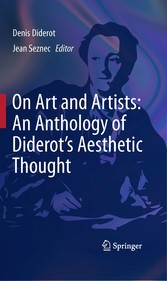Suchen und Finden
Contents
6
Introduction
10
Notes
19
Definitions
21
Beauty
21
Beauty Is the Perception of Relations
21
Beauty in Nature and Art
22
God and the Artist
23
Beautiful Nature and the Ideal Model
24
False Art
28
Art and Pantomime
29
The Sublime
30
Style
31
Genius and Inspiration
33
What Is Genius?
33
A Composed Genius
34
Inequalities of Inspiration
35
The Drawing and the Finished Work
36
Views on Sculpture
36
Difficulties of Sculpture
36
Its Limits and Its Merits
37
The Sculptor’s Temperament
39
Views on Architecture
39
Architecture, Mother of the Arts
39
Architecture and Location
41
Architecture and Its Destination
41
The Condition of Art
44
Emulation and the Virtue of Public Exhibitions
44
One Should Institute a Contest
44
On a Same Theme for Artists
44
Luxury
45
Sane Wealth, Which Comes from Agriculture, is the Only One Which Is Useful to the Fine-Arts
The Spendthrift Buyer Degrades Them45
The Collectors
48
They Reduce the Artist to Slavery
48
They Keep for Themselves Works That Should Be Displayed for Public Enjoyment and Education and to Inspire Competition
48
They Dispise Taste by Prefering Minor Scenes and Belittling the Great Ones
49
Climate and Costume
50
The Academic Model
50
The Positive Philosophical Intellect
52
The Ruin of the State
54
Criticism
55
Can a Literary Person Be an Art Critic?
55
His Ignorance of the Vocation Appears to Prohibit Him
55
How Diderot Taught Himself, Due to His Functionas a Salonnier
56
Contained Within the “Ideal” Part of Art, Can the Literary Person Be the Better Judge than the Artist Himself
56
The Artist Recognizes Implicitly the Superiority of the Writer on This Point
58
The Idea and the Way to Do It. Diderot Purveyor of Subjects
59
Priority of the Idea
59
Diderot Thinks as a Painter
59
He Also Knows to Conceive as a Sculptor
60
He Can Improve the Artist’s Concept as Well as Guide Him
62
Qualities of a Critic
63
Imagination and Memory
63
Sensibility
64
The Pleasure to Praise
64
Indulgence
65
Frankness and Charity
65
Opinion and Posterity
66
History
69
The Great Style
69
The Sword or Bellone Presenting His Horses’ Reins to Mars
72
Paganism and Christianity
73
Christian Characters Are Lacking and Spiteful
However the Great Masters Ennoble Them by Borrowing from Ancient Characters75
Two Summits of Religious Painting of the Eighteenth Century
76
Modern History
80
Why Painters Are Not Amenable to Modern History
80
Diderot Proposes a Subject in Modern History
82
Allegory
82
The Triumph of Justice
83
The Process of Description
84
Comparison
84
Dialogue
85
The Dream
87
Grimm
88
Diderot
88
Grimm
89
Diderot
89
Grimm
89
The Countryside
90
The Qualities of a Landscape Artist
90
The Complete Landscapist
90
The Intelligence of Light
91
A Morning After the Rain
92
Prelude to a Storm at Sunset
92
Artificial Nature: Boucher
93
The Shepherds of the OPÉRA-COMIQUE
93
Another Pastoral Setting
94
Same Grandeur, Same Form and Same Merit as the Preceeding One
94
In Boucher’s Defense
94
Nature and History
96
Praise for Vernet
96
How Poussin Raises a Landscape to the Dignity of History
97
The Picturesque: Loutherbourg
98
Battles, Ruins and Shipwrecks
99
The Painter of Battles Must Be a Poet and Dramatist
99
The “Poetry” of Ruins
100
Moral Associations
100
Romantic Shipwrecks
102
The Portrait
105
The State and Appearance
105
La Tour’s Ideas
105
The Usual Expression
106
Concerning Ones Own Portrait
108
Portraits and Models
108
The Portrait and History
109
The Downfall of the Portrait
110
The Type
112
True Subjects
112
The Russian Baptism
114
Feigned and True Moral Painting
115
Baudoin
115
The Feelings of Love and Nature, Allowing Time for Necessity
115
Greuze
117
The Type and History
120
Anecdotal Necessity
120
The Respective Merits of the Historical Painter and the Scene Painter
Their Differences Are Those between Poetry and Prose121
Still Life
124
Chardin
124
Ideal and Technique
126
Diderot in the Painter’s Space
128
The Averted Look: Diderot and the Boundaries of Representation
153
Composition According to Diderot
165
The Ambiguties of Definition Concerning Composition Within the Encyclopédie
167
Planning as Guarantee to Comprehension
170
Planning as Value-Added Interest to a Painting
172
Composition as Unifier
175
Composition as Determinant of the Artist’s “Must”
180
An Enlightened Aesthetic
184
As Conclusion
186
Notes
187
Alle Preise verstehen sich inklusive der gesetzlichen MwSt.
























